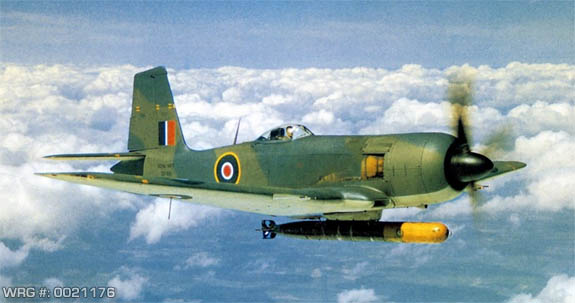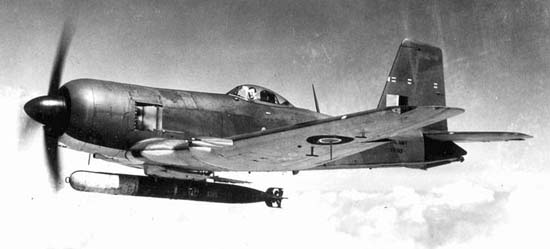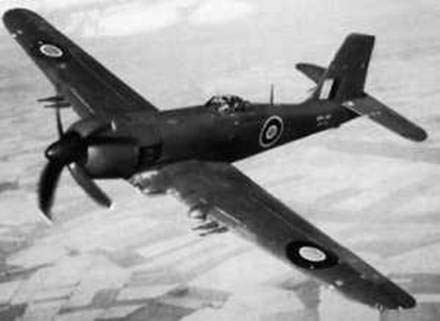BRITISH AVIATION RESOURCE CENTER > FIGHTERS > PREVIOUS PAGE

|
Type: Strike Fighter Origin: Blackburn Aircraft Designed by: G. E. Petty Models: Mk. I-V Crew: one First Flight: February 27, 1942 Service Delivery: 1943 Retired: 1953 Number Produced: 193 POWERPLANT: Model: Centaurus IX Manufacturer: Bristol Type: 18-cylinder radial engine Number: One Horsepower: 2,500 hp Dimensions: Wing span: 51 ft 3½ in (15.62 m) Length: 39 ft 1 in (12 m) Height: N/A Wing Surface Area: 381.5 ft² (35.44 m²)
Weights: |
Performance: Maximum speed: 350 mph (560 kph) Cruise speed: 289 mph (465 kph) at 10,000 ft (3,050 m) Stall speed: 75 mph (121 kph) Range: 1,250 mi (2,000 km) with torpedo and drop tanks Rate of climb: 2,600 ft/min (13.2 m/s) Wing loading: 41.7 lb/ft² (203.6 kg/m²) Power/mass: .157 hp/lb (347 W/kg) Armament: Guns: 4 × 20 mm (0.79 in) Hispano Mk.II cannon. – two in each wing
Bombs: |
The Blackburn Firebrand was a single-engine fighter aircraft designed to Air Ministry Specification N.11/40 by Blackburn Aircraft. It was designed around the Napier Sabre III 24-cylinder H-type engine as a single-seat fleet fighter for the Royal Navy.

Work on the B-37 Firebrand proceeded slowly. An unarmed prototype first flew on 27 February 1942, the armed Firebrand F Mk. I second prototype flying on 15 July of that year. The Sabre engine was also used in the Hawker Typhoon, a fighter already nearing production, and was earmarked for that aircraft. A new engine was needed, along with airframe improvements to handle it; along with these modifications it was deemed appropriate to convert the Firebrand into a strike fighter capable of carrying torpedoes, bombs, and rockets as well as engaging in air to air combat. Only nine production F Mk. I aircraft were built. The Firebrand was unusual in that there was an airspeed gauge mounted outside of the cockpit so that during landing the pilot would not have to look down into the cockpit to take instrument readings, presaging the development of the modern heads up display.

The Firebrand TF Mk. IV (B-46), as the new development was designated, featured a newer Centaurus IX engine and larger tail surfaces for better low-speed control. The enlarged rudder was horn balanced, and the wings now featured dive brakes on both upper and lower surfaces. The TF Mk. IV first flew on 17 May, 1945, and was the first version of the Firebrand to enter mass production, with 102 built. The later Firebrand TF.5 featured minor aerodynamic improvements and was also built in large numbers, with 68 entering service. A further 40 TF Mk. IVs were converted to the TF.5 standard.
The final production version was the Firebrand TF Mk. 5A. The design was further developed into the unsuccessful Firecrest
Sources:
Wikipedia
BRITISH AVIATION RESOURCE CENTER > FIGHTERS > PREVIOUS PAGE
